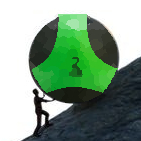Photo: The Three Vinegar Tasters, a painting depicting Kongzi, Buddha, and Laozi. The expressions on the three masters' faces are said to represent their takes on life: sour in Kongzi's due to his belief that humanity is fundamentally useless without strict control, bitter in Buddha's because he believes that life is primarily about suffering, and sweet in Laozi's because Daoism believes that life is fundamentally good.
A Very Brief Overview of Daoism
The Daodejing (or Tao Te Ching, or Laozi in keeping with the tradition of naming the work after its author), often translated as The Classic on the Way and Virtue is the foundational document of Daoism. Little is known about its pseudonymous author, Laozi (which translates to “old teacher”); according to popular legend, he wrote it as he was leaving China for good in response to political turmoil.
Despite this obscure origin (or perhaps in a sign that this story is apocryphal), Laozi’s writings attracted a following, and Zhuangzi and Wenzi both added their own entries to the Daoist canon. Zhuangzi’s book of the same name delves into Daoist cosmogony and includes some parable illustrations of Daoist philosophy and ethics (the “de” part of the Daodejing). His direct contributions are known as the “inner” chapters of the Zhuangzi and those added by his students later the “outer” chapters.
The Daodejing stands in substantial contrast to its contemporary philosophies, Confucianism and Mohism, all of which emerged during the Hundred Schools of Thought, a period of major philosophical output in pre-modern China that wrestled with the decline of the political situation into the chaotic Warring States period after the failure of the Zhou dynasty. Scholars in the Hundred Schools struggled to find a way to return to stability; Kongzi (Latinized to Confucius) stressed adherence to tradition and loyalty to the family unit and state. Mozi insisted on what might be called radical equality and also the appeasement of ghosts. Daoism, meanwhile, stressed individualism and living in harmony with nature.
The debate was eventually settled temporarily by Legalism, which enjoyed substantial state support after Qin Shihuangdi united the warring states and suppressed all other philosophies during the relatively brief period between assuming power and dying from all the mercury he took in a counterproductive bid at immortality. Confucianism emerged as the big winner in the dynasties that followed, but Daoism survived alongside it. It was not uncommon for folks to be Confucianist in public and Daoist in private.
Daoism: Philosophy or Religion?
We can try to answer this question by analyzing the core Daoist canon or examining how the school of thought has been carried forward (and arguably muddled and diluted) through history. It’s generally argued that the Daodejing is a philosophical text rather than a religious one; Laozi does not preoccupy himself with questions of the supernatural or the afterlife and doesn’t provide anything that might lend itself to incorporation into a concrete religious practices.
The apparent agnostic nature of the text means that Daoism in the narrow sense has lent itself very well to syncretism and become Daoism in the wide sense. Laozi’s teachings were incorporated relatively readily into traditional premodern Chinese religious practices, where Laozi entered the pantheon as a demigod-like figure and belief in ritual and magic melded with the more philosophical teachings of the Daodejing (some western sources refer to this process as a “distortion”). This branch is sometimes called “jiao” or ritual Daoism. The philosophical branch is known as “jia” Daoism.
It’s in this philosophical branch that things get messy. Daoism got picked up by Buddhism, becoming Chan, and later Zen Buddhism as the latter continued its eastward journey to Japan. Meanwhile, preoccupations with immortality and the supposed mystical powers that come with attaining unity with the Way (possibly echoes of Buddhism’s preoccupation with attaining enlightenment) manifested in the form of Daoist alchemy. As opposed to Western alchemy, Daoist alchemy believed that immortality could be attained by mastering an esoteric set of meditation exercises. Exemplars of this branch include 18th century practitioner Liu Yiming, author of The Secret of the Golden Flower among others. Another set of practices known as The Bedroom Arts also arose during this period, about which the less said the better.
Okay, but what is Daoism Really? An Overview of Fundamental Concepts
- The Dao: Typically translated as the Way in English, the Dao is the underlying set of principles that govern the order of nature and its many expressions. The goal of Daoism is to find alignment with the way, made somewhat difficult because it is both sublime and ineffable. In what’s often translated as the first line of the Daodejing, Laozi writes “The Way that can be spoken of is not the eternal Way.” Any form of philosophy not rooted in direct experience is therefore discussing only lesser emanations of the Way.
- Yin and Yang: Though neither original to nor confined to Daoism, its frequent discussion of duality and the interplay of opposites have resulted in the yin-yang symbol (less naively referred to as the Taiji; or, to Robert Jordan fans, the Aes Sedai symbol but upside down and with dots in it) being associated with Daoism. Male and female, light and dark, and heat and cold are complimentary forces that must be harmonized both within and outside the sage
- Nondiscrimination: The sage does not preoccupy herself with good and bad, as embodied in a famous folkloric narrative:
One day the sage’s neighbor’s mare ran away. The neighbor lamented his misfortunate to the sage, but the sage serenely replied “How do you know this is a bad thing?”
The mare returned several days later, bringing with her a magnificent wild stallion. The neighbor rushed to the sage to report his fortune, but the sage merely replied “How do you know this a good thing?”
A week later, the neighbor’s son was thrown from the stallion and broke his wrist. The neighbor again rushed to the sage, but the latter asked again “How do you know this is a bad thing?
While the son convalesced, recruiters from the imperial army arrived to conscript able-bodied men. Because the son’s wrist was broken, he was spared. The sage smiled.
- Wu wei: Translated as “without action” or “without striving,” the sage allows things to become rather than forcing them into being; when the sage leads, her followers believe that they are accomplishing everything by themselves. Practicing wu wei becomes about freeing oneself from attachment to outcomes.
- Social renunciation: A more controversial aspect of Daoism, as embodied in the Zhuangzi as the metaphor of the crooked tree. The sage does not make herself useful and thereby prevents her own exploitation. The tree that cannot be used for wood and that does not bear fruit isn’t cut down.
- The Three Treasures: One of the passages in the Daodejing refers to the "three treasures": humility, simplicity, and compassion (translated by Le Guin, they are "mercy, moderation, and modesty"); these principles generally form the core of discussions of ethics in Daoism.
A Note on Translation and Links
The Daodejing has been the subject of numerous translations; most are good except for Stephen Mitchell’s - I feel like he departs too much from the text in an effort to modernize it; granted, this is coming from solely having read other translations, so YMMV.
Mitchell aside, Moss Roberts and Thomas Cleary's The Essential Dao, which also has the inner chapters of the Zhuangzi, have more academically oriented translations; Moss Roberts also includes an introduction on the history of translating the Daodejing that I didn't get into because I'm already running long.
Ursula K Le Guin is a notable devotee of Daoism; her translation of the Daodejing can be read here .
I also like Ray Griggs's The New Lao Tzu , which is a more lyrical take without Mitchell's missteps (in my opinion).
Announcements & Information
Megathreads and spaces to hang out:
❤️ Come listen to music with your fellow Hexbears in Cy.tube
💖 Come talk in the New weekly queer thread
🧡 Monthly Neurodiverse Megathread
💛 Read about a current topic in the news
⭐️ May Movie Schedule ⭐️
Reminders:
💚 You can join specific comms to see posts about all sorts of topics
💙 Hexbear’s algorithm prioritizes comments and discussions over upbears
💜 Sorting by new makes your comrades happy
🌈 If you ever want to make your own megathread, you can go here
Links To Resources (Aid and Theory):
spoiler
Aid:
💙 Comprehensive list of resources for those in need of an abortion -- reddit link
💙 Resources for Palestine
Theory:
❤️ Foundations of Leninism
❤️ Anarchism and Other Essays
❤️ Mega upload with theory for many tendencies


Gotta feeling hammerfell is not gonna be 99% black people like skyrim was 99% white people
wait, hammerfell is going to have black people?
oh brother, can't wait to see g*mers rise up.